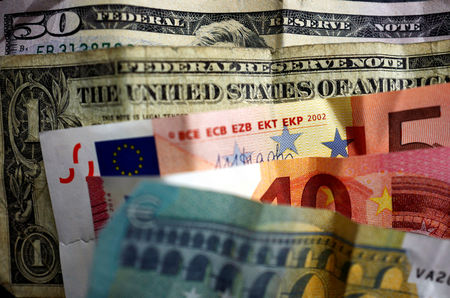Forex
Euro slumps on political uncertainty; dollar looks to Fed meeting

Investing.com – The euro slumped Monday, falling to a one-month low, on rising regional political uncertainty, while the U.S. dollar awaits the Federal Reserve’s meeting later in the week.
At 04:0 ET (08:20 GMT), slumped 0.3% to 1.0764, after falling as low at 1.0748 earlier in the session, a one-month low.
Euro slumps on political uncertainty
The single currency slumped Monday after the results from the European Parliament elections, which concluded on Sunday, showed eurosceptic nationalists made the biggest gains.
This prompted French President Emmanuel Macron to call a snap legislative election, taking a gamble to try to reestablish his authority by calling after sharp gains by far-right political rival Marine Le Pen.
“While Marine Le Pen’s National Rally party has shifted away from the anti-euro manifesto it ran on in 2017, fears about shifting support for Ukraine stand to unnerve markets,” said analysts at ING, in a note.
“EUR/USD may well have another leg lower to the 1.0700/0720 area once U.S. investors fully have a chance to appreciate events in European politics.”
Dollar hands back some gains
The U.S. dollar edged lower Monday, handing back some of Friday’s strong gains, as traders awaited the latest meeting as well as the release of the latest inflation data.
At 04:00 ET, the , which tracks the greenback against a basket of six other currencies, traded 0.1% lower at 104.790.
The greenback received a boost late last week, climbing to a near one-month high, after data showed stronger than expected growth in in May, reducing the perceived chances of rate cuts by the Federal Reserve this year.
Markets are now pricing in 36 basis points of Fed cuts this year compared to nearly 50 bps – or at least two cuts – before the jobs data.
The Fed concludes its latest two-day policy meeting on Wednesday, and is widely expected to leave rates unchanged.
The spotlight instead will be on comments from Chair , any changes to economic projections, as well as key U.S. data.
fell marginally to 1.2724, with sterling trading in a tight range ahead of the Bank of England’s next later this month.
BOJ meeting looms large
In Asia, traded 0.1% higher to 156.90, with the yen remaining weak even as data showed Japan’s economy shrank slightly less than expected in the first quarter.
But the economy still remained squarely in contraction.
The meets later this week, and the central bank is expected to begin tightening policy by reducing its asset purchases. But how much the BOJ can tighten policy remains uncertain, given that the economy remains weak.
traded largely unchanged at 7.2477, with the pair remaining close to six-month highs as the Chinese economy continued to battle with an uneven economic recovery.

 Forex3 years ago
Forex3 years agoForex Today: the dollar is gaining strength amid gloomy sentiment at the start of the Fed’s week

 Forex3 years ago
Forex3 years agoUnbiased review of Pocket Option broker

 Forex3 years ago
Forex3 years agoDollar to pound sterling exchange rate today: Pound plummeted to its lowest since 1985

 Forex3 years ago
Forex3 years agoHow is the Australian dollar doing today?

 Cryptocurrency3 years ago
Cryptocurrency3 years agoWhat happened in the crypto market – current events today

 World3 years ago
World3 years agoWhy are modern video games an art form?

 Commodities3 years ago
Commodities3 years agoCopper continues to fall in price on expectations of lower demand in China

 Economy3 years ago
Economy3 years agoCrude oil tankers double in price due to EU anti-Russian sanctions


























